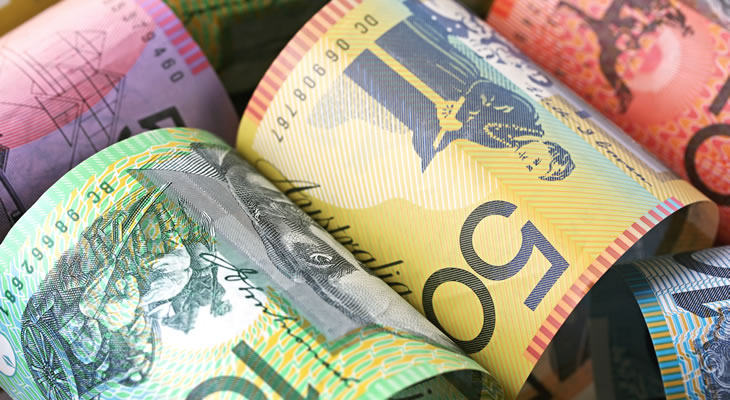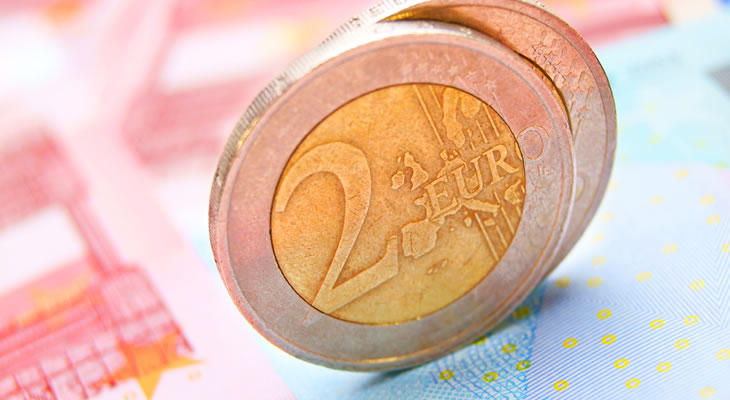- EUR AUD oversold – Relative Strength Indicators suggest Euro uptrend
- Latest ECB bulletin forecasts medium-term weak inflation – Sluggish global growth also forecast
- EONIA curve lower – Banks expecting further monetary stimulus?
- EUR AUD long-term currency forecast – Exchange rate could strengthen due to potential for Euro to appreciate
The ECB may be predicting low inflation over the coming months, but there are signals that the EUR AUD exchange rate is oversold, suggesting upwards pressure for Euro forecasts in the medium term.
EUR AUD Paring Losses; Both Currencies Resisting US Dollar Strength
A stellar jobs creation figure from the US has strengthened the US Dollar. While the Euro and the Australian Dollar have both felt the dragging effect of the latest US Non-Farm Payrolls data, which showed 255,00 new jobs were created in July, Fed rate hike bets still remain low, undermining some of the ‘Greenback’s bullishness. EUR AUD is currently trading around 1.4550.
(Last updated 16.55, 05/08/16)
ECB Economic Bulletin Points to Subdued Global Growth, Clouding Forecasts for Long-Term EUR AUD Exchange Rates
The European Central Bank’s (ECB) latest Economic Bulletin suggests that the financial market volatility seen in the wake of the UK’s decision to exit the European Union has already subsided. This removes one major headwind for the long-term Euro Australian Dollar exchange rate forecasts, with past claims that the Eurozone would be hit harder by the UK’s Brexit decision than Britain itself seeming largely unfounded at this juncture.
According to the bulletin summary;
‘Overall financial conditions remain highly supportive. In particular, while the EONIA forward curve has shifted downwards, especially at longer horizons, possibly reflecting expectations of both lower growth and further monetary policy actions, followed by low-risk sovereign bond yields, sovereign spreads vis-à-vis ten-year German government bonds have narrowed and those on corporate bonds have continued to tighten. At the same time, Euro area banks’ equity prices have declined further.’
EONIA – the Euro Overnight Index Average – is the average interest rate that Eurozone banks charge to lend each other money. If this is rising, it suggests banks are getting ready for higher interest rates from the ECB, while if it is falling this indicates bank expectations are for looser monetary policy. With the Economic Bulletin pointing to a downside shift in the EONIA forward curve, this points to weaker forecasts of positive economic conditions and heightened anticipation of ECB monetary stimulus measures.
All in all, the downward path of EONIA could keep the Euro Australian Dollar (EUR AUD) exchange rate bearish in the medium to long-term.
Official Cash Rate Weakens Australian Dollar; Fewer Headwinds from RBA for AUD in the Medium-Term?

As was widely expected, the Reserve Bank of Australia (RBA) cut interest rates to a fresh historical low of 1.5% at its latest policy meeting this week. However, due to strong market expectations of a cut, investors had already largely priced-in the chances of looser policy and so the ‘Aussie’s subsequent weakening was short-lived.
UBS believe that the Reserve Bank of Australia is done with policy easing for the time being, commenting;
‘Key to the decision was the RBA concluding “prospects for sustainable growth in the economy, with inflation returning to target over time, would be improved by easing monetary policy at this meeting” (…identical to its post cut comment in May). The RBA followed their normal practice of providing no explicit ‘forward guidance’ on policy at meetings where they adjust rates.
We believe the RBA is likely to present only a weak easing bias, or even near-neutral statement, either in Friday’s SoMP [Statement on Monetary Policy] or September’s post-meeting press release, consistent with our view that the RBA is now on hold.’
The Statement on Monetary Policy indicated that inflation was set to remain low, around the bottom of the RBA’s target 2-3% until the end of 2018 at the least, despite the rate cut delivered by policymakers. As well as another rate cut in 2016, markets have priced in further policy easing for 2017 as well. While the RBA has revised its long-term Australian Dollar exchange rate forecasts higher, expecting the trade weighted index to rise from 62.5 to 63.5, this is above the current market level, suggesting further downwards pressure for AUD EUR forecasts.
EUR AUD Long-Term Exchange Rate Forecast; Oversold Euro May Resist Potential Australian Dollar Appreciation
However, while the Australian Dollar has slipped on a trade-weighted basis from its fifteen-month-high of 65.40, AUD is trading closer to the top of its twelve-month range; 3.4% below its yearly high compared to 6% above the twelve month low. This leaves more room for Australian Dollar depreciation and the current Relative Strength Indicators for EUR/AUD suggest the pairing has been on a rebound since dropping to a 17-month low of 30.30 in mid-July. An RSI score below 30 suggests that the base currency – in this case the Euro – is being oversold; people are disproportionately selling Euros to get Australian Dollars. This tallies with recent comments from the Reserve Bank of Australia (RBA) that the Australian Dollar is overvalued.
As a result, with plenty of room for depreciation within the 52-week range and a rebounding RSI index that is currently significantly below its 2016 peak of around 68, this would suggest that the Australian Dollar may weaken further over the coming months. Further policy action from the Reserve Bank of Australia is forecast because of the Australian Dollar’s current strength, as demonstrated by the latest indicators, so the ‘Aussie’ could face additional central bank efforts to devalue it, as well as being weakened by markets speculating on the undervalued EUR/AUD pairing.
Current AUD EUR Conversion Rates
The Australian Dollar Euro (AUD EUR) exchange rate was trending at a nine-day high of 0.6849 on the 4th of August, while the Euro Australian Dollar (EUR AUD) exchange rate traded at 1.4612.


Comments are closed.